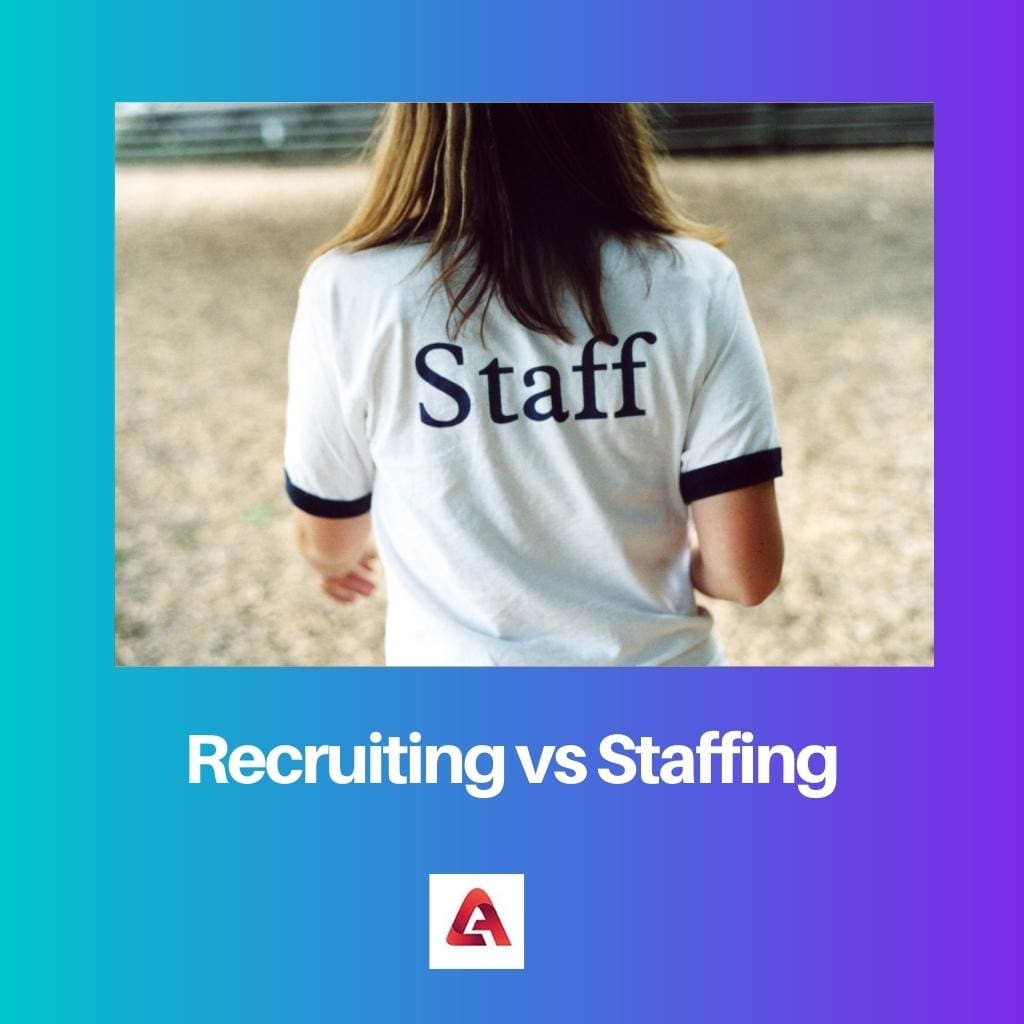In any organization or business, each person contributes their bit to lead the organization to success. The staff members have different roles assigned to them.
If a place remains vacant, it has to be filled up to ensure the proper functioning of the organization. The process of filling the vacant position is sometimes referred to as recruiting and some other times as staffing.
Key Takeaways
- Recruiting refers to identifying, attracting, and selecting suitable candidates for a job vacancy. At the same time, staffing manages the workforce after completing the recruitment process.
- Recruiting involves creating job descriptions, posting job ads, reviewing resumes, and conducting interviews, while staffing involves training, performance management, compensation, and benefits administration.
- Recruiting focuses on finding the right candidate for a specific job, while staffing involves managing the workforce and ensuring that it aligns with the organization’s goals.
Recruiting vs Staffing
Recruiting is the process of identifying and attracting qualified individuals for job openings, involving activities such as sourcing, screening, and interviewing candidates. Staffing is a broader phrase that includes recruiting and actions linked to people management, such as staff training, scheduling, and performance evaluation.

Recruiting for the vacant position refers to finding the best fit.
Staffing is a collective term referring to the acquisition, employment, development and retention of people in the organization.
Comparison Table
| Parameter of Comparison | Recruiting | Staffing |
|---|---|---|
| What does it mean? | Recruitment is finding the best potential that fits the position completely. In this procedure, candidates are invited to apply for the post. After that, through a certain procedure, the best candidate is selected among them to find the candidate that fills the position efficiently. | Staffing is a collective term that refers to the processes starting from recruiting candidates and continuing to maintain suitable and skilful human resources in the organization. |
| What is its role | Recruitment is done to fill the vacant positions with suitable human resources. | Staffing is done so that the organization can function efficiently and can have a lead on the way to success. |
| Type of function and its scope | Recruitment is a process or sub-process of staffing; therefore, it has a limited scope. | Staffing is a managerial process that consists of several procedures, and therefore it has a much wider scope. |
| Occurrence level | Recruitment occurs at the initial or early stages of any organization. | Staffing is a procedure that occurs at each level in an organization starting from the top position to the lowest position. Also, it starts when one joins an organization and ends when he leaves it. |
| Time horizon | Recruitment is short-term because it only involves finding the best potential for a particular position. | Staffing is a long-term process since it starts from the initial stage of recruitment and continues to retain human resources successfully. |
What is Recruiting?
Recruiting is finding the best potential for a vacant place in an organization. Recruitment starts with inviting candidates to apply for the further process and then conducting a pre-defined procedure to select the best candidate among them for the position and continues till the final selection is made.
During the recruitment procedure, candidates are pooled through advertisements in magazines, newspapers, news channels, social media, etc. Depending on the vacant profile, recruitment can be conducted within or outside the organization.
The recruitment process aims to hire passive candidates looking forward to employment. It is conducted at the early levels in an organization. Also, it is a short-term procedure that ends when the right candidate is hired.
Recruitment can be termed as a sub-process of staffing.

What is Staffing?
Staffing can be referred to as adding and maintaining capable human resources in an organization. It is a collective term referring to acquiring, developing, maintaining and retaining an organisation’s people.
Staffing can also be termed as filling open roles in an organization. Staffing is a managerial process carried out at each level in the organization; therefore, it has a wider scope.
It starts with recruitment and continues to retain the recruited candidates successfully.
Staffing aims to seek active employers to play general and specific roles; it also aims at recognizing the importance and efficiency of each employer and assigning them roles based on their capabilities. It manages the employer throughout their work cycle.

Main Differences Between Recruitment and Staffing
- The term recruiting refers to finding the best possible potential for a vacant position in an organization; on the other hand, the term staffing is a collective term for recruiting, managing, developing and retaining the people in the organization.
- Recruitment is carried out to fill the vacant positions in the organizations; on the other hand, staffing is carried out for the betterment of the organization and to contribute towards the institution’s success.
- Recruiting is a sub-process of staffing, whereas staffing is a managerial process.
- Recruitment only has a single step, whereas staffing involves a series of steps or procedures.
- The scope of recruitment is less, whereas the scope of staffing is much wider than recruitment.
- Recruitment is carried out in an organization at the early stages; on the other hand, staffing is carried out at each level.
- Recruitment is a short-term procedure since it ends after finding a suitable candidate for the position. In contrast, staffing is a long-term procedure since it starts from recruitment and ends when a person leaves the organization.

- https://psycnet.apa.org/journals/cpb/59/2/91/
- https://onlinelibrary.wiley.com/doi/abs/10.1111/j.1744-6570.1993.tb00866.x

The article’s insightful perspective on the intricacies of recruiting and staffing is truly commendable, delivering substantial value to readers.
The author’s nuanced approach to elucidating the differences between recruiting and staffing is most impressive.
The information presented in the article reflects a deep understanding of the subject matter, which is both insightful and educational.
The article provides a comprehensive understanding of the difference between recruiting and staffing, which is essential for the efficient functioning of any organization. The infographic is quite helpful as well.
The comparison table is very informative and sheds light on the nuances of both recruiting and staffing.
I particularly enjoyed the section about what recruiting and staffing mean. It perfectly highlights the key differences between the two terms.
This article presents an eloquent and exhaustive analysis of recruitment and staffing, providing readers with a holistic comprehension of the two processes.
The article’s distinguished portrayal of recruiting and staffing adds tremendous value to the discourse on organizational management.
The depth and clarity of the information provided in this article are truly exceptional.
I appreciate the detailed analysis of what recruiting and staffing entail. The article offers an in-depth look at these crucial functions within organizations.
The article effectively dissects the key elements of recruitment and staffing, offering a well-rounded understanding of both processes.
The article’s detailed comparison between recruiting and staffing brings a fresh perspective to these essential organizational functions.
The comprehensive overview of recruiting and staffing is an excellent resource for professionals seeking to expand their knowledge.
The article does an exemplary job of elucidating the variances between recruiting and staffing, elucidating the complexities of both processes with remarkable clarity.
The article’s thorough and articulate exploration of recruiting and staffing is truly enlightening.
The section comparing the main differences between recruitment and staffing is particularly enlightening and provides valuable knowledge for readers.
I found the breakdown of recruitment and staffing to be exceptionally clear and cogent.
The article provides an intelligent delineation of the variances between recruiting and staffing, making it an indispensable resource for professionals and organizations alike.
Agreed, the article does a stellar job of highlighting the complexities within each process.
The article does an excellent job of breaking down complex concepts into easily understandable points. It’s a great resource for anyone looking to familiarize themselves with the intricacies of recruiting and staffing.
I agree, the comparison table really simplifies the core distinctions between the two concepts.
The clarity and depth of information in this article are commendable. A very insightful read.